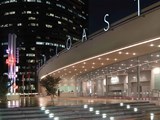By Brian Robin
What Was La Havana Madrid?
There is nothing remarkable or distinguishable that identifies 959 W. Belmont Ave. on Chicago’s North Side as a touchstone of musical and cultural history. Upstairs, where nightclub goers once cut many a rug, only hair is being cut now.
Standing outside, you see the Belmont L station. A few blocks south stands Wrigley Field, the nearest familiar landmark to anyone who never experienced the electricity created at 959 W. Belmont. Never experienced the music, the community, the passion, the stories, the history that happened nightly at what was once a must-stop for all of the top Latin big-band, jazz and salsa bands of the 1950s and 1960s.
That was La Havana Madrid, the legendary nightclub/community hub for Chicago’s Cuban, Colombian and Puerto Rican communities of the 1960s. And playwright/actor Sandra Delgado is bringing the long-gone nightclub back to life at Mission San Juan Capistrano this summer in Outside SCR’s production of LaHavana Madrid, running July 15-Aug. 4.
When you think of legendary Latin bandleaders such as Desi Arnaz or Xavier Cugat conducting their orchestras, they did so in clubs such as La Havana Madrid. And if you were a popular Latin musician of that era; think Tito Puente, Celia Cruz, Cheo Feliciano, the Fania All-Stars, La Havana Madrid was a tour stop.
But it didn’t start as one.
According to Carolina Aloma-Gibbs, the daughter of Cuban-born Chicago White Sox relief pitcher Luis Aloma, her father started the club as a chapter of the Cuban American Society. Luis Aloma was president of the society, which served as a community hub for Latin immigrants. Citing notes from the club’s secretary, the Chicago Tribune reported that in 1962, a jacket and tie was required for admittance in the evenings, beer sold for 45 cents a pint, dinners were a Sunday night staple and the lounge was open nights and weekends for ping-pong, pool and dominoes.
Eventually, La Havana Madrid morphed from community center to community nightclub. A stylish dining room opened and chefs served a full Cuban/Spanish menu. When Delgado talked to Aloma-Gibbs—who found her on Facebook after rehearsals for the initial production at Chicago’s Steppenwolf had begun—Aloma-Gibbs told her the china had green edging with gold flakes.
Even as the production went into rehearsals, detail after detail revealed itself to Delgado, who eagerly gathered them as she went, building an image of the club once frequented by her parents.
In 1966, Tony Quintana, a prominent Puerto Rican businessman, radio and television personality who hosted the 1960s radio show “Tony’s Latin A-Go-Go,” bought La Havana Madrid. He brought in A-list Latin talent such as Cruz, Bobby Capo and Pedro Vargas and used his popular radio show to promote the club.
Quintana, one of the characters in La Havana Madrid, stayed only two years, leaving in 1968 to concentrate on his other businesses. The Chicago Tribune quotes Quintana in his self-published book, The Tony Quintana Story: Memorias de un Boricua Ausente, that City Hall and the Chicago Mob made it “impossible” to operate La Havana Madrid.
The club closed in 1969, becoming another famous cultural hotspot: The Quiet Knight, where the next generation of club goers could brag they saw the likes of Bruce Springsteen, Bob Marley and Jimmy Buffett before they were Bruce Springsteen, Bob Marley and Jimmy Buffett. Other clubs came and went at 959 W. Belmont throughout the ’70s, ’80s and ’90s.
Now, it’s a hair salon, but the memories of La Havana Madrid live on in Delgado’s musical-infused memory play.


